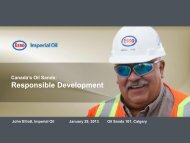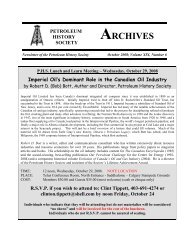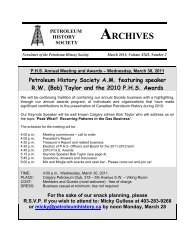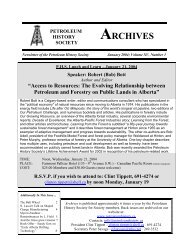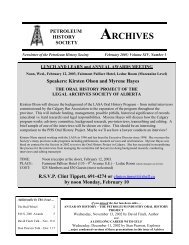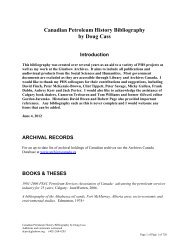PDF format - The Petroleum History Society of Canada
PDF format - The Petroleum History Society of Canada
PDF format - The Petroleum History Society of Canada
You also want an ePaper? Increase the reach of your titles
YUMPU automatically turns print PDFs into web optimized ePapers that Google loves.
PETROLEUM<br />
HISTORY<br />
SOCIETY<br />
ARCHIVES<br />
Newsletter <strong>of</strong> the <strong>Petroleum</strong> <strong>History</strong> <strong>Society</strong> March 2004; Volume XV, Number 3<br />
P.H.S. ANNUAL GENERAL MEETING – March 17, 2004<br />
Speaker: Dave Mitchell<br />
Oil Industry Executive and Company Builder<br />
“<strong>The</strong> Evolution <strong>of</strong> Alberta Energy Company (AEC)”<br />
Dave Mitchell was President and Chief Executive Officer <strong>of</strong> Alberta Energy Company (AEC)<br />
from the beginning <strong>of</strong> its operations in 1975 until 1993 when he became Chairman <strong>of</strong> the<br />
Board. He retired as Chairman in 1999. Dave will review the history <strong>of</strong> the company and<br />
provide background on its unique creation and activities during his tenure as CEO. Starting<br />
as a four-person operation, AEC grew to become a very large and successful participant in<br />
the oil and gas industry. This is the story <strong>of</strong> an Alberta event that has some interesting<br />
chapters. Prior to AEC, Dave was CEO <strong>of</strong> Great Plains Development Company. He has<br />
been prominent in a number <strong>of</strong> business and community activities.<br />
For those members wishing to brush up on their AEC history from the period prior to its<br />
amalgamation with PanCanadian in 2002, please refer to the September 4, 2000 issue <strong>of</strong><br />
Oilweek Magazine which featured “Celebrating 25 years <strong>of</strong> Growth” concerning the company.<br />
TIME:<br />
PLACE:<br />
COST:<br />
4:00 p.m., Wednesday, March 17, 2004. Reception 4:00 – 4:20 p.m.,<br />
Business Meeting 4:20 – 4:50 p.m. and Guest Speaker 5:00 – 5:45 p.m.,<br />
Concluding with Mix and Mingle with friends and colleagues 5:45 – 6:30 p.m.<br />
Fairmont Palliser Hotel (133 - 9 th Avenue S.W.) – Marquis Room (check marquee).<br />
No charge for Members and Guests (most welcome)<br />
R.S.V.P. if you wish to attend to: Clint Tippett, 691-4274 or<br />
clinton.tippett@shell.ca by noon Monday, March 15<br />
Additionally In This Issue ...<br />
<strong>The</strong> Bull Wheel 2<br />
Frank Dabbs Talk on<br />
“Before Leduc” 4<br />
<strong>Society</strong> for Industrial<br />
Archeology 6<br />
<strong>The</strong> Oilmen’s Bonspiel 8<br />
Archives is published approximately 6 times a year by the <strong>Petroleum</strong><br />
<strong>History</strong> <strong>Society</strong> for <strong>Society</strong> members. Back issues are archived on our<br />
website at:<br />
www.petroleumhistory.ca<br />
Contacts: info@petroleumhistory.ca<br />
President Clint Tippett – clinton.tippett@shell.ca 691-4274<br />
Secretary Peter Savage - p2savage@telus.net 249-3532
THE PETROLEUM HISTORY SOCIETY<br />
THE BULL WHEEL<br />
Next Board Meeting: <strong>The</strong> Executive and Board are reminded that the next meeting will be at<br />
3:30 p.m. on March 17, 2004 at the Fairmont Palliser Hotel, Spanish Room, immediately prior<br />
to the Annual General Meeting in the Marquis Room.<br />
Election <strong>of</strong> P.H.S. Executive and Board: This month’s Annual General Meeting marks the<br />
renewal <strong>of</strong> our <strong>Society</strong> through the election <strong>of</strong> a new Executive and Board <strong>of</strong> Directors. While<br />
most <strong>of</strong> the existing volunteers have indicated a willingness to continue in their present<br />
capacity, we are always on the lookout for people with the energy and dedication to help us<br />
grow and to undertake projects on our behalf. From a bylaws point <strong>of</strong> view, there are no<br />
automatic rollovers from, for example, Vice-President to President (with the obvious exceptions<br />
<strong>of</strong> President to Past-President and Honourary Director), so all Executive and BOD positions<br />
are “open”. Please contact Nominations Committee members Clint Tippett (691-4274), Doug<br />
Cass 268-4203) or Hugh Lieper (249-0707) if you would like to get involved.<br />
Next Luncheons: On April 21 Shawn Howard <strong>of</strong> Imperial Oil will address us on the history <strong>of</strong><br />
the Lynwood refinery site and later housing that has been in the news over the last few years.<br />
Craig Lamb <strong>of</strong> Husky will be speaking at our May 19 luncheon on the history <strong>of</strong> well logging. If<br />
you would like to present the results <strong>of</strong> a project that you’ve been working on, please let us<br />
know and we will fit you in. Contact Clint Tippett, President P.H.S., at 691-4274 or Director<br />
Debbie Knall at 780-463-3859 (Edmonton).<br />
P.H.S. Membership and Renewals: Micky Gulless, Past President and Membership<br />
Coordinator, has indicated that P.H.S. membership now stands at 145. Thanks to all <strong>of</strong> you<br />
who have so promptly sent in your renewals and a reminder to those <strong>of</strong> you who have not that<br />
the A.G.M. traditionally marks the cut<strong>of</strong>f <strong>of</strong> benefits for non-payment <strong>of</strong> dues.<br />
Oral <strong>History</strong> Project: David Finch, interviewer and project manager, has indicated that Bill<br />
Fisher (gas processing engineer), Peter Moore (geologist) and Orrin (Lee) Slind (geologist)<br />
were interviewed during the latter half <strong>of</strong> 2003. Transcripts <strong>of</strong> the interviews are being<br />
processed through the Glenbow Museum and Archives.<br />
Leduc/Devon Oilfield Historical <strong>Society</strong> Update: <strong>The</strong> latest issue <strong>of</strong> this <strong>Society</strong>’s “Catwalk”<br />
newsletter records their successful fundraising over the last year, specifically: “Our Wall <strong>of</strong><br />
Honor” continues to be popular, raising $1,900 to display names <strong>of</strong> retirees, supporters and<br />
those who have passed on. In labour and materials we have raised the equivalent <strong>of</strong> $64,000<br />
and cash donations totaled $223,000. $120,000 was received from Petro-<strong>Canada</strong> towards<br />
<strong>Petroleum</strong> <strong>History</strong> <strong>Society</strong> Archives: March 2004; Volume XV, Number 3 Page 2
preserving the Atlantic #3 wellsite and in part was used to purchase the land for the <strong>Society</strong>.<br />
Large donations were received from CAPP, Abe Wiessenborn, BJ Services <strong>Canada</strong>, Keith<br />
Snyder, Marilyn Morrison, Nexen and Universal Compression.<br />
P.H.S. Pin Sets: Our pin sets (<strong>of</strong> 6) have recently been reduced in price to $40.00. Please<br />
contact Joyce Wright at 252-4143 if you are interested in buying one or several sets. <strong>The</strong>se<br />
make great and original Calgary- or Western <strong>Canada</strong>-related gifts. Detailed comprehensive<br />
descriptions accompany each plush-boxed set.<br />
Winners (and Losers), Continued: Globe and Mail “Report on Business magazine” November<br />
2003. (Smilin’) Jack Gallagher in the Mogul category for the 1970’s. “Jack Gallagher, founder <strong>of</strong><br />
Calgary-based Dome <strong>Petroleum</strong> Limited, is convinced that the Arctic contains more oil than the<br />
Middle East. Dome becomes <strong>Canada</strong>’s largest independent oil company, reaching $2.9 billion in<br />
revenues by the start <strong>of</strong> the ‘80’s. But by 1982 the company has amassed over $7 billion in debt.<br />
A year later, Gallagher is forced out by creditors and, five years after that, an insolvent Dome is<br />
purchased for $5.5 billion by Amoco <strong>Canada</strong>.”<br />
Turner Valley: An item in the Calgary Herald <strong>of</strong> December 10, 2003 by Maria Canton stated that<br />
“Plans to divert the Sheep River by up to 60 metres in order to stop contaminants filtering into the<br />
water system from a nearby historic site are expected to be approved next week, says a<br />
Provincial Government spokesman. Alberta <strong>of</strong>ficials are waiting for the Federal Department <strong>of</strong><br />
Fisheries and Oceans to give them the green light to move the river banks near the Turner Valley<br />
Gas Plant, clearing the way for the final multimillion dollar cleanup.” Another individual is quoted<br />
as saying that “In 1995, a flood moved the Sheep River closer to the (gas plant) and we plan to<br />
move it back to its original path. That distance, along with a permanent containment wall, will<br />
stop any migrating hydrocarbons and maintain the integrity <strong>of</strong> the site for the long term.” Some<br />
area residents had apparently expressed concern over the risk <strong>of</strong> contamination <strong>of</strong> the local water<br />
municipal water supplies both in Turner Valley itself and downstream.<br />
Perspectives: I recently read that there is a demobilized <strong>of</strong>fshore rig in Galveston, Texas<br />
Harbour that has been converted into a museum called the “Ocean Star Museum”. Might be<br />
worth a look if you are ever down that way. Also recently read that the Alaskan lobby group<br />
“Arctic Power” which has been trying to get the Arctic National Wildlife Refuge (ANWR) opened<br />
to drilling has lost much <strong>of</strong> it’s industry support and has had to resort to bingos and pull tab sales.<br />
<strong>The</strong>se folks must really believe in what they are after!<br />
Oil Patch Humour:<br />
1. I found a book in the Library discards called “Exploring Careers for the Gifted”. I noticed it<br />
because it has a picture <strong>of</strong> two geologists on the cover doing fieldwork. Imagine my<br />
disappointment (being a geologist) when I found that there was nothing about geologists in the<br />
book!<br />
2. Did you hear about the two cartoon characters that they are planning to use as part <strong>of</strong> an<br />
upcoming joint convention between the petrophysicists <strong>of</strong> the Canadian Well Logging <strong>Society</strong> and<br />
the geophysicists <strong>of</strong> the Canadian <strong>Society</strong> <strong>of</strong> Exploration Geophysicists? See the end <strong>of</strong> this<br />
section for the answer.<br />
3. We <strong>of</strong>ten wonder why the general public doesn’t understand the oil industry. Is it any wonder<br />
when we call a well that’s flowing thousands <strong>of</strong> barrels <strong>of</strong> water a day “dry” and describe vast<br />
tracts <strong>of</strong> <strong>of</strong>fshore holdings as “land”?<br />
(Answer: Archie and Jughead (after Gus Archie, the father <strong>of</strong> modern petrophysics and “jughead”<br />
- a term sometimes used for field hands on geophysical acquisition crews).<br />
<strong>Petroleum</strong> <strong>History</strong> <strong>Society</strong> Archives, March 2004, Volume XV, Number 3 Page 3
LUNCHEON PRESENTATION TO THE PETROLEUM HISTORY SOCIETY<br />
FEBRUARY 18, 2004<br />
“Before Leduc” and Some Musings on the Meaning <strong>of</strong> <strong>History</strong><br />
by P.H.S. Director Frank Dabbs<br />
We thank Frank for making this manuscript available to us and for its partial publication in this <strong>format</strong>.<br />
I’d like to make several points today:<br />
• That while the Leduc oil discovery was a milestone <strong>of</strong> enormous significance in Alberta<br />
history, it was the product <strong>of</strong> a long succession <strong>of</strong> milestones <strong>of</strong> equal significance.<br />
• That we Albertans and Canadians have been, in the past, far too myopic in our sense <strong>of</strong><br />
ourselves and <strong>of</strong> our importance in the world. To mix the metaphor, we have a weakness for<br />
looking at ourselves through the wrong end <strong>of</strong> the telescope. Our <strong>Petroleum</strong> Imperium is<br />
made <strong>of</strong> very thin, frail, fragile fabric.<br />
• That, happily for this organization, we have a very long way to go before we can claim to<br />
have done justice to the subject <strong>of</strong> oil and gas history and its meaning and import in the life <strong>of</strong><br />
our citizens and our community.<br />
• <strong>The</strong> most important insight I have gained since presenting this paper for the first time is the<br />
significance <strong>of</strong> what I now call the Hudson’s Bay fur trading company moratorium on<br />
resource development in northwest North America, which lasted from 1670 to 1870.<br />
• HBC controlled the north west corner <strong>of</strong> North America and all its wealth, but could only<br />
afford, and was only interested in, harvesting beaver pelts.<br />
• It’s stewardship created a template for colonial thinking by governments about Western<br />
Canadian oil and gas development that plays through modern history right up to the National<br />
Energy Policy <strong>of</strong> 1980.<br />
• Colonialism and neo-colonial structures impaired resource development in Western <strong>Canada</strong><br />
until Leduc, and continue to impair it today.<br />
• Colonialism in Alberta oil and gas politics did not end until the 1985 Western Accord – and<br />
the processes that the federal government is hinting at for Kyoto implementation indicate that<br />
colonialism is still in the incubator.<br />
<strong>The</strong> Purpose <strong>of</strong> <strong>History</strong><br />
Seen from our perspective at the beginning <strong>of</strong> the 21 st Century, the discovery <strong>of</strong> the Leduc<br />
Woodbend Devonian oil reef by Imperial Oil in 1947, which began the Contemporary Period<br />
in Canadian oil and gas development, came some time past the midpoint <strong>of</strong> petroleum<br />
industrialization in Alberta and the Canadian West. Leduc No. 1 came in 57 years ago this<br />
month. Drilling began on the landmark discovery well on November 20, 1946. But the<br />
beginning <strong>of</strong> the modern commercial development <strong>of</strong> Alberta's petroleum resources, the<br />
beginning <strong>of</strong> that place we call the Oilpatch; the beginning <strong>of</strong> the Western Canadian industrial<br />
sector that has made Calgary what it is, preceded Leduc by seven decades. On September<br />
7, 1875, John Macoun, a natural scientist doing field work for the Geological Survey <strong>of</strong><br />
<strong>Canada</strong>, first grasped and recorded the potential <strong>of</strong> the Athabasca tar sands and wrote the<br />
report that led to the first oil sands commercialization experiments at the Royal Military<br />
College in Kingston, Ontario in 1883. It was Macoun who first caught the single strong tide <strong>of</strong><br />
history upon which the Leduc geologists and drillers were carried, and we are still carried<br />
today. Although in the chronology <strong>of</strong> global petroleum and natural gas development, this was<br />
early – it might have been earlier still except for what I call the Hudson’s Bay Company<br />
natural resources moratorium.<br />
<strong>Petroleum</strong> <strong>History</strong> <strong>Society</strong> Archives: March 2004; Volume XV, Number 3 Page 4
<strong>The</strong> Leduc story has become a part <strong>of</strong> our culture; and assumed the legendary quality <strong>of</strong> a story<br />
that helps us to define our commonality. Such stories give us the gift <strong>of</strong> community; but a<br />
community only endures if it also has a history.<br />
Canadian scholar <strong>of</strong> literature, theology and history, Northrop Frye, wrote, "Every human society<br />
possesses a mythology, which is inherited, transmitted and diversified by literature." He also<br />
said: "In our culture, some narratives dealing with personalities run parallel to a sequence <strong>of</strong><br />
events external to themselves; others are based on a sequence <strong>of</strong> events that seems to be<br />
constructed for its own sake. This distinction is reflected in the difference between the words<br />
‘history’ and ‘story’.<br />
Leduc is a story and it cannot become history until we know what came before it.<br />
In the second half <strong>of</strong> the 20 th Century, researchers, authors and journalists; pr<strong>of</strong>essional and<br />
amateur historians; assembled a remarkably complete archival and bibliographic record <strong>of</strong><br />
Alberta's and <strong>Canada</strong>'s petroleum history and produced many good books that record the early<br />
stories <strong>of</strong> the oil patch. <strong>The</strong> prevailing reason, in my view, for the quality and extent <strong>of</strong> the record<br />
is that people from within the industry drove this work. For them and most <strong>of</strong> their peers in the<br />
industry, employment in the Oilpatch, in exploration and production, on the pipelines and in the<br />
refineries, was a way <strong>of</strong> life as well as a job or a career.<br />
It is a somewhat unique sociological and anthropological phenomenon. And is similar experience<br />
to that in Canadian mining. Out <strong>of</strong> this passion has come a wonderful record. With a century and<br />
a quarter <strong>of</strong> a shared experience behind us, we have our body <strong>of</strong> common stories, we have our<br />
shared mythology. But is that the same as having a history?<br />
French historian Fernand Braudel, who lived and worked through the middle <strong>of</strong> the 20 th Century<br />
and got much <strong>of</strong> his perspective from being interned in a Nazi concentration camp, distrusted<br />
conclusions about history that were drawn from the very recent past, and even the not-so-recent<br />
past. He looked for the patterns that mattered in what he called “la longue durée” <strong>of</strong> history and<br />
defined as, “those deep, underlying forces that invade our lives and shape the world.”<br />
"Events are crests <strong>of</strong> foam that the tide <strong>of</strong> history carries on its strong back”, Braudel wrote:<br />
"Individuals do not make history; history above all makes individuals what they become. <strong>History</strong><br />
is the keyboard upon which individual notes are sounded. <strong>The</strong> true person <strong>of</strong> action is the one<br />
who can measure most nearly the constraints upon himself, and who chooses to remain within<br />
them and even to take advantage <strong>of</strong> the weight <strong>of</strong> the inevitable, exerting his own pressure in the<br />
same direction." Braudel also asserted that: "To teach or write history is to discover a sense <strong>of</strong><br />
perspective, <strong>of</strong> the reality <strong>of</strong> past time; its direction and significance and the successive<br />
landmarks that gave it shape."<br />
When journalist and author Blair Fraser was asked to complete the six-volume Canadian history<br />
series edited by historian and novelist Thomas Costain, by writing, in the early 1960's, the story<br />
<strong>of</strong> his current century, he wrote: "Yesterday's news is tomorrow's history. Meantime there is<br />
today, when it is deemed unfit for either category. For the one too old; for the other still unripe,<br />
still awaiting the nice blend <strong>of</strong> new knowledge and new ignorance that gives history the<br />
appearance <strong>of</strong> pattern and clears away the untidiness <strong>of</strong> reality." Every writer and biographer<br />
who attempts to record the significance <strong>of</strong> his times, to write about its leaders and its leading<br />
influences, faces Blair's dilemma <strong>of</strong> being caught in the limbo that lies between the news and<br />
history. As we work to build the literature that becomes the unifying mythology <strong>of</strong> our culture, we<br />
are confronted by the task <strong>of</strong> discerning the difference between the strong tide <strong>of</strong> history and the<br />
short-lived foamy waves that ride on its back.<br />
<strong>Petroleum</strong> <strong>History</strong> <strong>Society</strong> Archives, March 2004, Volume XV, Number 3 Page 5
Greasing the Skids in Victoria 1966.<br />
Workers at Victoria Machinery Depot prepare heavy timbers for the launch <strong>of</strong> part <strong>of</strong> the<br />
SEDCO 135F drilling rig by applying a thick layer <strong>of</strong> lubricating grease (Shell <strong>Canada</strong>).<br />
SEDCO 135F near launch date, 1967, in Victoria Harbour, B.C.<br />
This massive rig drilled fourteen <strong>of</strong>fshore wells along the coast <strong>of</strong> British Columbia on a<br />
continuous basis between 1967 and 1969 and later moved to New Zealand (Shell <strong>Canada</strong>).<br />
___________________________________________________________________________________________________________________<br />
<strong>Petroleum</strong> <strong>History</strong> <strong>Society</strong> Archives: March 2004; Volume XV, Number 3 Page 6
Overview <strong>of</strong>: “<strong>Society</strong> for Industrial Archeology”<br />
By P.H.S. President Clint Tippett<br />
Some time ago I stumbled upon a membership recruitment brochure for the “<strong>Society</strong><br />
for Industrial Archeology”. Having an interest in old petroleum industry sites like the<br />
Turner Valley Gas Plant and various old train-related locations (another strange habit<br />
<strong>of</strong> mine), I decided to join and have since become more familiar with the activities and<br />
interests <strong>of</strong> those in the group. Some relevant in<strong>format</strong>ion follows:<br />
Based In:<br />
Website:<br />
Meetings:<br />
Publications:<br />
Tours Offered:<br />
Michigan Technological University, Houghton, Michigan<br />
www.sia-web.org or www.siahq.org<br />
Various locations – the brochure I had was related to “Montreal<br />
2003” and was focussed on Montreal’s industrial heritage. <strong>The</strong><br />
2004 AGM is in Providence, Rhode Island.<br />
A glossy quarterly newsletter is published and a more scholarly<br />
journal comes out twice a year.<br />
To Catalonia, Spain (running now) and Sweden. Fall 2004 tour to<br />
Wilmington, Delaware.<br />
According to their promotional material the SIA was formed in 1971 to “promote the<br />
study, appreciation and preservation <strong>of</strong> the physical survivals <strong>of</strong> our industrial and<br />
technological past. <strong>The</strong> word “archeology” underscores the <strong>Society</strong>’s principal<br />
concern with the physical evidence <strong>of</strong> industry and technology – the study,<br />
interpretation and preservation <strong>of</strong> historically significant sites, structures, buildings,<br />
artifacts, industrial processes, bridges, railroads, canals, landscapes and<br />
communities.” [I was crushed – nothing to do with the oil industry (yet)].<br />
“<strong>The</strong> SIA is a non-pr<strong>of</strong>it, international, interdisciplinary organization that brings together<br />
people <strong>of</strong> varied backgrounds who share a common interest in the archeology<br />
industry, engineering, and technology in general. Our diverse membership is our<br />
greatest asset. It includes architects, archeologists, engineers, industrialists, museum<br />
specialists, planners, historians, preservationists, teachers, students, retirees and<br />
many non-pr<strong>of</strong>essionals for whom industrial archeology is an exciting avocation.”<br />
<strong>The</strong>ir pitch is ”Keep the Industrial Past Alive – Join the <strong>Society</strong> for<br />
Industrial Archeology. Textile mills, machine shops, automobile assembly<br />
plants, workers’ housing, bridges <strong>of</strong> all types … <strong>The</strong>se and other industrial<br />
and engineering sites and structures have a unique ability to teach us<br />
about life and work in the industrial age, to show us how things were (and<br />
are) made, and to tangibly demonstrate how industry and technology have<br />
shaped our environment and our history. With knowledge, the stuff <strong>of</strong><br />
everyday life – from the factory on Main Street to the cast iron manhole<br />
cover on your street – comes alive.”<br />
Dues are $35.00 U.S. for individuals. Please contact me at 691-4274 if you’d like<br />
more in<strong>format</strong>ion.<br />
___________________________________________________________________________________________________________________<br />
<strong>Petroleum</strong> <strong>History</strong> <strong>Society</strong> Archives: March 2004; Volume XV, Number 3 Page 7
“THE OILMEN’S BONSPIEL”<br />
By R.J. Bob Dunn<br />
With Bob’s permission - from the poetry Compilation:<br />
“And the Grass Grew Greener as I Meandered through the Oil Patch”<br />
published 2000 by Dunderosa Publications<br />
Bob’s Introduction:<br />
<strong>The</strong> Oilmen’s Bonspiel is pretty much the way it happened to those who were bonspielers, more<br />
than curlers. Bonspiels in some <strong>of</strong> the smaller centres were more like an endurance contest<br />
than a sporting event. Because some <strong>of</strong> the curling rinks had only a couple <strong>of</strong> sheets <strong>of</strong> ice,<br />
curling went on around the clock in order to get in the required number <strong>of</strong> games that it took to<br />
name a champion in the time available to do so. Curlers would be on the ice with two hours<br />
on, and two hours <strong>of</strong>f, until the job was done. A Rig Manager who I invited to curl with me in<br />
just such an event, and who had never curled before, said “I’d be happy to, but since I don’t<br />
know anything about the game, why don’t I shoot last?”<br />
<strong>The</strong> Oilmen’s Bonspiel<br />
“Come on Joe, there’s no more snow<br />
And the muskeg’s starting to thaw.<br />
It’s breakup time, so let’s all climb<br />
In the pickup, and make the first draw.”<br />
“I’ve heard them say, down Edmonton way,<br />
<strong>The</strong>y’re going to have a “Spiel”.<br />
We’ll get our nose in the pail,<br />
Chase a little quail,<br />
It sounds like a hell <strong>of</strong> a deal!”<br />
“<strong>The</strong>re’ll be booze and broads,<br />
And I’ll give you odds<br />
We won’t get too much sleep.<br />
We’ll get a few crocks, throw a few rocks,<br />
But I’ll be damned if I will sweep!”<br />
So the boys went to town to let their hair down,<br />
And see all the other guys.<br />
But once they got there,<br />
<strong>The</strong>y started to care<br />
About going home with a prize.<br />
<strong>The</strong> first game was a disaster<br />
<strong>The</strong>y really gassed her,<br />
Everyone missed a few.<br />
<strong>The</strong> odd wrong turn, a crucial broom burn,<br />
Put them in event number two.<br />
___________________________________________________________________________________________________________________<br />
<strong>Petroleum</strong> <strong>History</strong> <strong>Society</strong> Archives: March 2004; Volume XV, Number 3 Page 8
“It’s okay men, it’s just our plan<br />
To get in the right event!”<br />
But the Skip was drunk,<br />
His game just stunk,<br />
And down to number seven they went.<br />
This game was better,<br />
<strong>The</strong> lead could set her<br />
Right in the house each time;<br />
But with a clutch shot, right on the pot,<br />
<strong>The</strong> other skip sent them down to nine!<br />
“Come on you guys, if everyone tries,<br />
We can keep our chances alive.<br />
Maybe a little drink,<br />
Would help our rink,<br />
After all, everyone’s guaranteed five!”<br />
Now they all started hitting,<br />
After six they were sitting<br />
Eight to one, they couldn’t lose,<br />
So they all agreed<br />
To get the lead<br />
To go and break out the booze.<br />
By the end <strong>of</strong> ten, they were tied again,<br />
What a hell <strong>of</strong> a game!<br />
But the booze was too much,<br />
<strong>The</strong>y lost in the clutch,<br />
Into the suitcase event they came.<br />
Now we’ve all been there,<br />
And it doesn’t seem fair<br />
When you just can’t seem to win.<br />
You’ve done your best<br />
Along with the rest,<br />
And losing is not a sin.<br />
When you’re home next night<br />
By the fires warm light,<br />
Missed shots won’t bring a tear,<br />
Good times with friends,<br />
Not screwing up ends,<br />
Will bring you back next year!<br />
___________________________________________________________________________________________________________________<br />
<strong>Petroleum</strong> <strong>History</strong> <strong>Society</strong> Archives: March 2004; Volume XV, Number 3 Page 9
BOOK OFFER FOR:<br />
Roughnecks, Rock Bits and Rigs:<br />
<strong>The</strong> Evolution <strong>of</strong> Oil Well Drilling<br />
Technology in Alberta, 1883-1970<br />
by B. A. (Sandy) Gow, Concordia University College <strong>of</strong> Alberta<br />
<strong>The</strong> University <strong>of</strong> Calgary press has approached the <strong>Petroleum</strong> <strong>History</strong> <strong>Society</strong><br />
with an <strong>of</strong>fer to sell us copies <strong>of</strong> this soon-to-be-released book at a substantial<br />
discount. It is described as follows:<br />
“This book traces the evolution <strong>of</strong> drilling technology in Alberta with an emphasis on the human<br />
side as well as technological aspects <strong>of</strong> the oil well industry. Gow’s portraits <strong>of</strong> former drillers and<br />
toolpushers add a nostalgic element to a well-researched and technologically savvy exploration <strong>of</strong><br />
this seminal Alberta industry. This is the first Alberta-specific book written on oil well technology,<br />
reserving a unique place on any bookshelf. <strong>The</strong> volume is handsomely and thoroughly illustrated<br />
with many photographs, maps and charts related to the industry. Gow has consulted a wide<br />
breadth <strong>of</strong> resources to obtain his materials including museum archives, interpretive centres and<br />
the personal collections <strong>of</strong> “old timers”.<br />
<strong>The</strong> <strong>Petroleum</strong> <strong>History</strong> <strong>Society</strong> is now taking orders for this book. With the<br />
<strong>of</strong>fered 40% discount, we estimate that the book will cost approximately $25.00<br />
including GST. If you would like to order one, please fill in the form below and<br />
send it with your cheque or money order in this amount to the <strong>Petroleum</strong> <strong>History</strong><br />
<strong>Society</strong>, c/o Doug Cass, Glenbow Museum and Archives, 130 – 9 Ave. S.E.,<br />
Calgary, Alberta T2G 0P3. Any differences from this price will either be charged<br />
or refunded.<br />
Name: __________________________________________________________<br />
Address: _______________________________________________________<br />
Phone Number: __________________ Form <strong>of</strong> enclosed payment: ______



